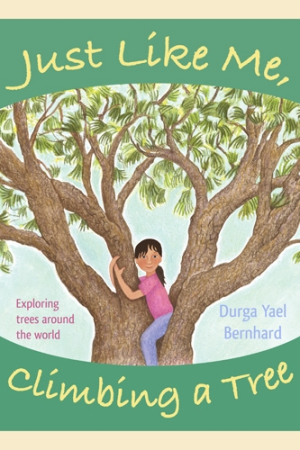Just like Me, Climbing a Tree
Caregivers who appreciate the value in unstructured, imaginative play as well as daily outdoor time will appreciate the book’s message.
Just Like Me, Climbing a Tree is a field guide and global tale about a childhood pastime. Author and illustrator Durga Yael Bernhard makes a strong case for outdoor exploration through charming art that includes a weeping willow in Holland, a white mulberry in Australia, a lychee in Hawaii, and a ginkgo in China. Latin and common names accompany each illustration, allowing children to experience the pleasure of specificity; a glossary features detailed descriptions of the trees. A treat for the beginning naturalist, and a worthy resource for parents and early childhood educators, this slim volume portrays scenes of abundance that inspire curiosity.
The sensory-rich story immediately invites readers to pay attention through poetic questions: “What if you / heard a bird / in the branches above, // and your feet / followed a root.” Continuing with the lines “or you shimmied up a trunk / so thick and tough, // and swung / like monkeys do,” Bernhard appeals to children’s delight in imitative behavior. She cleverly uses animal movements, birds, fruits, insects, and other common associations with trees to evoke a world in which children use them as ladders, shelters, lookouts, spaces to hide, and places for respite. A talent for slant rhymes, such as “dragonfly” and “eagle’s eye,” “treasures” and “changing weather,” create pleasing sounds.
The art’s summery palette fits the gentle tone. Layouts seldom vary—many of the trees are pictured as large-scale canopies with majestic trunks that span both pages, and children are often depicted climbing alone—which makes variations stand out. A weeping fig in Cambodia, surrounded by airy white space, reveals a network of roots that hint at underground mysteries; a baobab in South Africa is leafless, yet alive with a vibrant yellow bird, chameleon, interesting knot designs, and a second child peeking from behind a branch.
Backgrounds hint at lives in various countries through architectural details, including tiled rooftops in Mexico and thatched ones in South Africa, though the emphasis remains on showing children across cultures who engage in similar activities. The book also includes a note on safety, titled “Why You Should Be Careful When Climbing Trees.”
Aside from minor choices that could be strengthened—such as a fresher approach to the cover and title page, which feature window-like views of an illustration at their center, surrounded by busy typography—this is strong work. Caregivers who value unstructured, imaginative play as well as daily outdoor time will appreciate the book’s closing message, in which a tree is likened to a patient friend. This book is especially recommended for Waldorf and Montessori settings, whether in schools or home practices, for the winsome blend of poetry and life science.
Reviewed by
Karen Rigby
Disclosure: This article is not an endorsement, but a review. The publisher of this book provided free copies of the book and paid a small fee to have their book reviewed by a professional reviewer. Foreword Reviews and Clarion Reviews make no guarantee that the publisher will receive a positive review. Foreword Magazine, Inc. is disclosing this in accordance with the Federal Trade Commission’s 16 CFR, Part 255.

